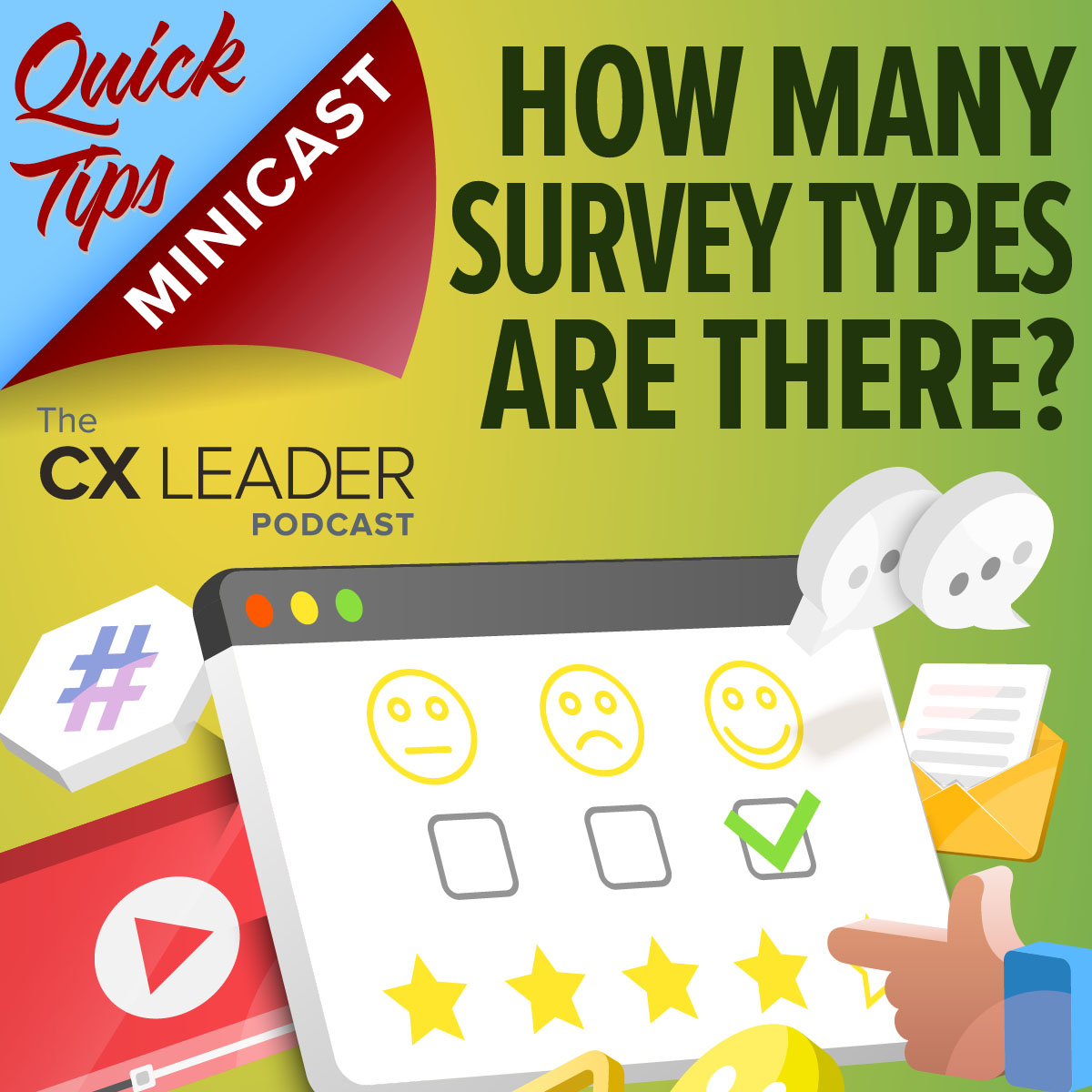
Quick Tips Minicast: How many survey types are there?
Release Date:

Most customer experience pros know about transactional and relational surveys, but did you know there’s a third kind of survey you may need to use? Add the confusion of which surveys are best sent often or once a year, versus how long they should be, it can get frustrating for you – or your customer – on deciding what survey to use when. Walker expert Heather Koiro clears up the “survey confusion” with her Quick Tip Minicast!

Heather Koiro
Walker
Connect with Heather
Transcript
The CX Leader Quick Tips Minicast: "How many survey types are there?": Audio automatically transcribed by Sonix
The CX Leader Quick Tips Minicast: "How many survey types are there?": this wav audio file was automatically transcribed by Sonix with the best speech-to-text algorithms. This transcript may contain errors.
Chris:
Hello everyone, I'm Chris Higgins, and welcome to another edition of The CX Leader Quick Tips Minicast, where Walker experts take a few moments to give you helpful advice on how to improve your XM programs. Joining me on this episode of the Minicast is Heather Koiro, a vice president and our client services here at Walker. Heather, thanks for being on the show.
Heather:
Thank you Chris.
Chris:
So what's your quick tip for our listeners?
Heather:
Many people refer to a survey as relational or transactional, but there are actually three types of surveys that I'm going to talk through with you today.
Chris:
All right. Three types of surveys. Let's hear about it.
Heather:
So there's three types of listening approaches. One being strategic, another being operational and the third being tactical. Strategic listening, that's about the perceived relationship a customer has with an organization. So it's a holistic assessment of their experience. And it measures the overall health of that relationship. And it's based on their lifetime experience. This type of survey informs executives and strategic decision makers. It provides an understanding on direction, and it diagnoses aspects that drive customer loyalty. And we have found this approach to be the most reliable data for predicting growth. Operational listening, that is more of a deep dive that determines if an organization met the customers needs throughout the duration of a specific journey phase. An example of this might be onboarding of a new customer. And this type of listening, it informs middle management, who then can affect the cultural change and optimize the operational and employees to identify not only what to fix, but then how to fix it. And then finally, the tactical listening measures a customer's experience during a single interaction. An example could be an interaction with a product delivery, or a specific website interaction, or a customer support interaction. A touchpoint survey gets a more accurate, detailed evaluation of that interaction soon after it takes place, and that's kind of the critical piece. It also can trigger a survey flag for an opportunity to close the loop, and informs frontline staff and their managers on areas that they can develop professionally. So as a listening program evolves, we recommend utilizing multiple approaches to gather the right type of feedback. And to give you an example, I have a client who conducts a relationship survey every 12 months, but also has ongoing transactional surveys to gauge how an installation or a service call went.
Chris:
All right. So I imagine each of these types of programs or approaches, you use the surveys in a different way, perhaps different frequency of surveys.
Heather:
So a relationship survey is typically conducted annually or like every 12 to 18 months, just depending on how quickly they can, um, implement initiatives to improve the experience. So it takes time to achieve those. For a journey survey that's ongoing and it is based off of a completion of a journey. But, you know, in those aspects, even though it's ongoing, you have to be cognizant of the fact that you don't want to fatigue your contacts. Right? So you need to build in rules that will minimize the amount of invitations that they would receive to participate. You know, an example could be I'm not going to contact a customer more than once every 90 days. And then for a transactional survey, that is something that's triggered immediately after an event. And we tend to see that no more than 48 hours after. And again, in this same instance, you want to incorporate some rules to minimize the number of times a contact can be invited in these particular situations.
Chris:
Yeah. And I imagine the length and compositions of these surveys of course would probably be different.
Heather:
They are a relational survey can tend to run 5 to 7 minutes. A journey survey would be about three minutes. And a transactional we would say no more than two minutes.
Chris:
Yeah, nothing more than 5 to 7 minutes. That's great. I've seen surveys from certain companies. I won't name that. They say to set aside 45 minutes of time. And so we generally don't recommend that, do we?
Heather:
Some of those are still out there. Um, but nowadays we know how critical time is. Um, and so it's more about focusing on the right things, getting the right content in there and getting that feedback.
Chris:
Of course. So how do you get started? What approach do you take?
Heather:
Typically a relational survey will be the starting point, and this is in order to capture a baseline and determine where to focus next. However, there could be a need to start with a journey or a transactional based survey, but it depends on current organizational strategies or initiatives that are in place. So you might have to flip the ordering, you know, in some instances. But typically we would start with a relational survey.
Chris:
All right. And is there any kind of particular type of questions that you would use in one versus the other?
Heather:
Yeah, a relational survey is typically going to be more high level, really wanting to kind of understand the brand. So it would include measures such as loyalty, NPS, CX principles. Then you'd get into more specifics around experience touchpoints, batteries of attributes related to those touch points, low score drill downs, maybe competitive evaluations, demographics, and then closing it with a kind of a catch all open end. And then for a journey and transactional surveys, those typically will include an overall experience with the recent journey or event and attribute battery that relates to it, low score drill downs, demographics. And again another kind of closing open end catch all.
Chris:
All right. Well Heather this is great information. Thank you for your quick tip.
Heather:
Thank you for having me Chris.
Chris:
If you want to listen to more great advice, go to cxleaderpodcast.com and be sure to follow the show. And if you have any questions or would like to hear more on a particular topic, send us an email. You can reach us at podcast@walkerinfo.com. Thanks for listening.
Sonix is the world’s most advanced automated transcription, translation, and subtitling platform. Fast, accurate, and affordable.
Automatically convert your wav files to text (txt file), Microsoft Word (docx file), and SubRip Subtitle (srt file) in minutes.
Sonix has many features that you’d love including enterprise-grade admin tools, transcribe multiple languages, share transcripts, secure transcription and file storage, and easily transcribe your Zoom meetings. Try Sonix for free today.
Tags: Chris Higgins Quick Tips minicast Heather Korio surveys relational transactional





